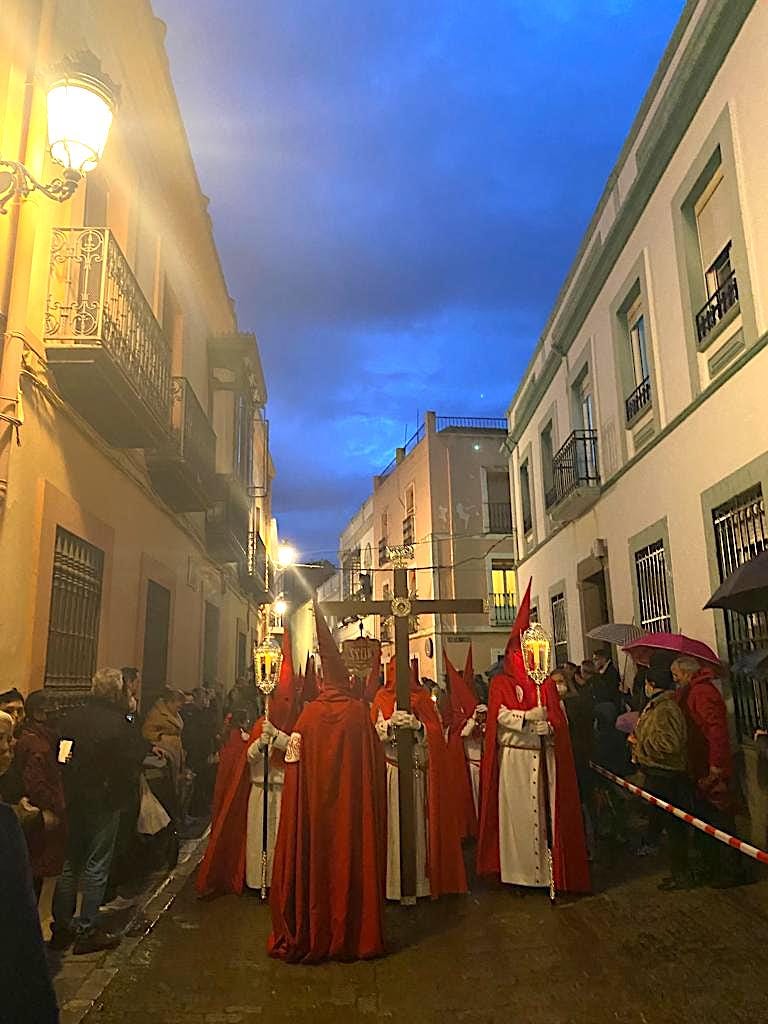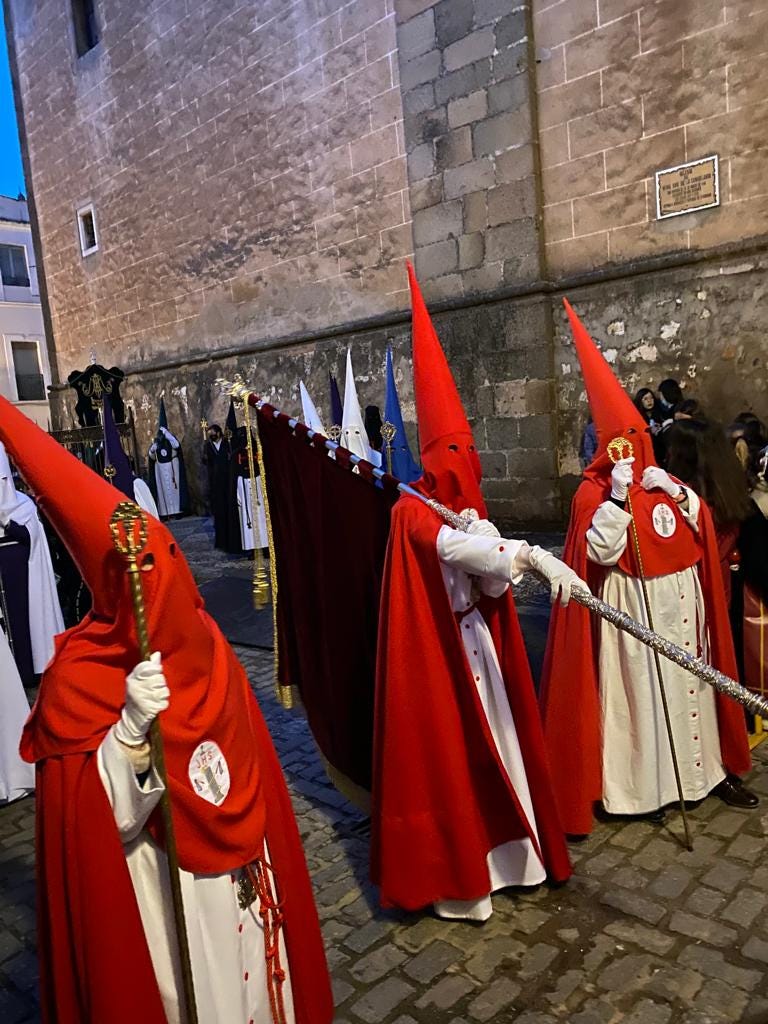Easter in Spain
Pagan roots, Catholic theology, Muharram, Ganesh Chaturthi, and the Ku Klux Clan.
Dear Global Jigsaw,
Apologies for the recent silence. I was in the US visiting family over the Easter break. I caught the cherry blossoms in Washington DC, which are second only to those in Japan, a real treat for a sakura-obsessed soul like mine. Towards the end of the week, friends with younger children began to talk about Easter egg hunts and I realised this was the first Easter in a while I hadn’t been in Spain, where the festival is something more elemental all together. It is as far a cry from bunnies and chocolate covered eggs, as Santa Klaus is from Jesus Christ.
For today’s post here’s a reprisal of a piece about Semana Santa, or Holy Week as the period between Palm Sunday to Easter Sunday is known as in Spain. This is seven days of candlelit processions led by hooded penitents, hauling floats of enormous wooden idols through medieval streets, to the steady beat of drummers. Under the overt Catholicism, it is possible to spy glimpses of Islam, paganism, and even Hinduism - with the right eyes. Easter in Spain bears the imprints of the cultural mélange - Arabic, Hebrew and Gypsy – that lies under the surface of the country. It is a substructure long layered over by the debris of Catholicism, modernity and secularism, but exposed every once in a while, as during Holy Week.
Two years ago, we happened to be in Zafra during the celebrations, a little-known town in the southwestern province of Badajoz. It is fairly typical for the region – dominated by a 15th century fortress and complete with church, town square and a network of narrow streets lined with high-walled homes.
A few candles already lit the gloaming as we shuffled through the crowds to get as close to the entrance of the church as possible. Ghostly figures shrouded in white robes, red capes and pointed hoods with slits only for the eyes, came streaming out of the doors.
Semana Santa procession in Zafra. Credit: Pallavi Aiyar
It was a shocking sight at first, the clothing being so reminiscent of the white-supremacist Ku Klux Clan. However, these robes predate the Clan by centuries. The conical head gear known as a capirote were first prescribed in Spain by the holy office of the Inquisition. Men and women arrested on suspicion of heresy had to wear a paper capirote in public as a mark of humiliation.
Semana Santa procession in Zafra. Credit: Pallavi Aiyar
In time, the hood was adopted by the cofradia, or Catholic brotherhoods, so that their members could remain anonymous when they took to the streets to whip themselves bloody, in penance for their sins, in a very Muharram-like display of religious fervour. Although self-flagellation as a part of religious processions was eventually banned in 1777, in practice it continued till well into the 20th century.
The penitents, or nazarenos, in Zafra were thankfully whip-free, but many walked barefoot despite the spring-chill. Others carried wooden crosses on their shoulders. Suffering remained a conspicuous motif of the procession.
Directly behind the first contingent of penitents, the paso, or float, emerged from the church to wild cheers from the onlookers. It was an enormous structure, with a life-sized idol of Jesus Christ on the cross, his face frozen in grief. Every Spanish town has its own paso, which range from the simple to the highly ornate. Most weigh a ton or two.
Celebration of Semana Santa in Malaga. Pic credit
About 40 people are required to hoist a paso on their heads. The carriers, called costaleros, stand directly under the tableaux and are hidden by fabric that covers falls on either side of the float. Only their feet are visible to onlookers.
Spanish costalero. Pic credit: Jorge Fernandez
I was forcibly, and unexpectedly, reminded of Hindu festivals like Ganesh Chaturthi, where idols of the elephant God are carried by processions through the streets of cities and eventually immersed in the sea.
Ganesh Visarjan (Immersion) procession in India. Credit: Snehal Jeevan Pailkar
There was in fact, an incident in 2017, when a group of Hindus carrying an idol of Ganesha were welcomed into a church in the Spanish city of Ceuta, with the gathered Christian congregation bursting into spontaneous hymns to welcome it.[2]
(You can watch a video of the event here: Ganesha in Cuenta. Watch it in particular from 20 minutes on)
Semana santa is heady stuff. I’d never imagined a brew with ingredients that included pagan roots, Catholic theology, Muharram-style flagellation, Ganesh Chaturthi-reminiscent processions, and outfits resonant of both Japanese construction workers and the Ku Klux Clan!
But the true marvel of the evening in Zafra was the accompanying music: a haunting mix of brass and drums.
I spent the next few days immersed in saetas. These are songs of lament sung during breaks in the processions, usually without any musical accompaniment. The word saeta means “arrow” in Spanish, referring to the way in which the song soars through the air, piercing the hearts of its listeners.
Music historians believe the song originated in late medieval monastic canticles, but later, the musical structure of the saeta broke free and was reshaped by Jewish converts to Catholicism in the sixteenth century. While some of these Jewish Catholic songs may have expressed genuine devotion to a newly embraced Christianity, others were coded expressions of the singer’s sorrow at having been forced to renounce, on pain of exile or death, their former faith.
The saeta was further developed by Spanish gypsies (gitanos), who have emerged as the music’s most popular interpreters today. Gitanos, of which there are upwards of 750,000 in Spain, do not have a well-documented history. But they are believed to have entered the Iberian peninsula during the 15th century. Linguistic analysis shows that they originated in northwestern India and migrated westwards in waves, between 300 BC and AD 600.
Gitanos have brought to the saeta elements of flamenco, music which at its core is also a lament against discrimination and prejudice. For the gitanos, Jesus Christ has become a symbol of their pain. The embrace of Spanish Catholicism by gypsies is a subversive act of appropriation that is little appreciated, even in Spain.
Consider this verse from a saeta:
Ya a viene el Cristo moreno (Here comes the dark-skinned Christ)
el Señor de los gitanos (Lord of the gypsies)
el mas grande y el mas gueno. (The highest and holiest)
Apretaitas las manos (With hands bound)
Pobre Jesús Nazareno.(Poor Jesus of Nazareth)
You can watch a saeta being sung during a semana santa procession in Seville here.(To the Indians reading this - tell me if it reminds you of a raga?)
*******
In Spain, the week-long festivities have come to an end, the idols are back at rest in their churches, and the nazarenos and casteleros have returned to their day jobs as accountants or truck drivers. But I am left awash in wonder, listening to saetas and marveling at this Global Jigsaw of a world.
******
I hope you enjoyed this glimpse into Spain. If so, could I ask you to become a paying subscriber to this newsletter? I do need the financial support to keep writing it, even though I wish I didn’t. Writing is my bread and butter, and every subscription means a smidgen more butter :-)
Also, it helps if you share my posts with your friends/family. So click here to share:
Until soon,
Pallavi










Amazing! Thank you for sharing this. I listened to the saeta and to me it sounded a lot closer to the Azaan. The cadences are exactly the same.
Great analysis Pallavi. As you point out the Semana Santa processions are beautifully grotesque, passionately supported by tradition rather than religion. I agree with the gipsy influence , but I also see Roman goddess….A celebration of the murder of God by humanity; parallel to toreros triumphs at bullfights?
Spain is certainly different